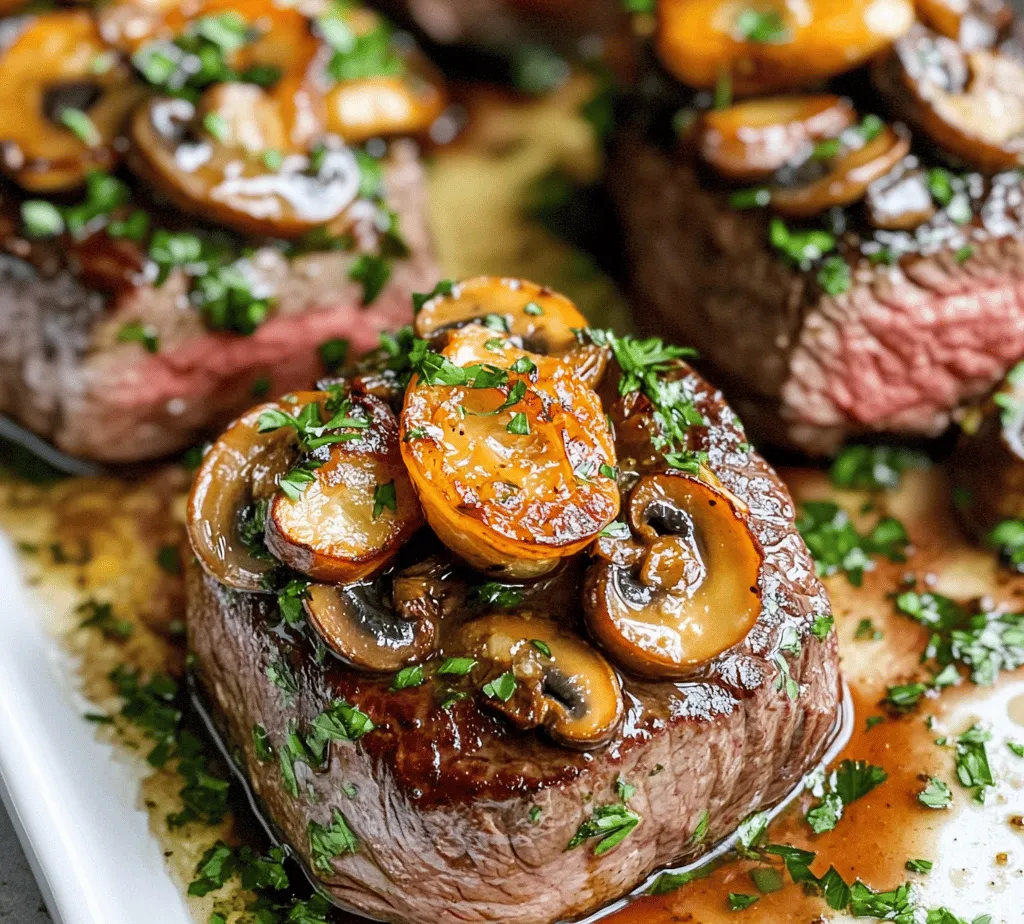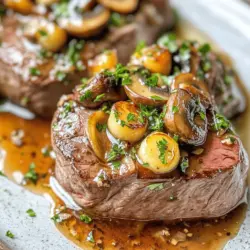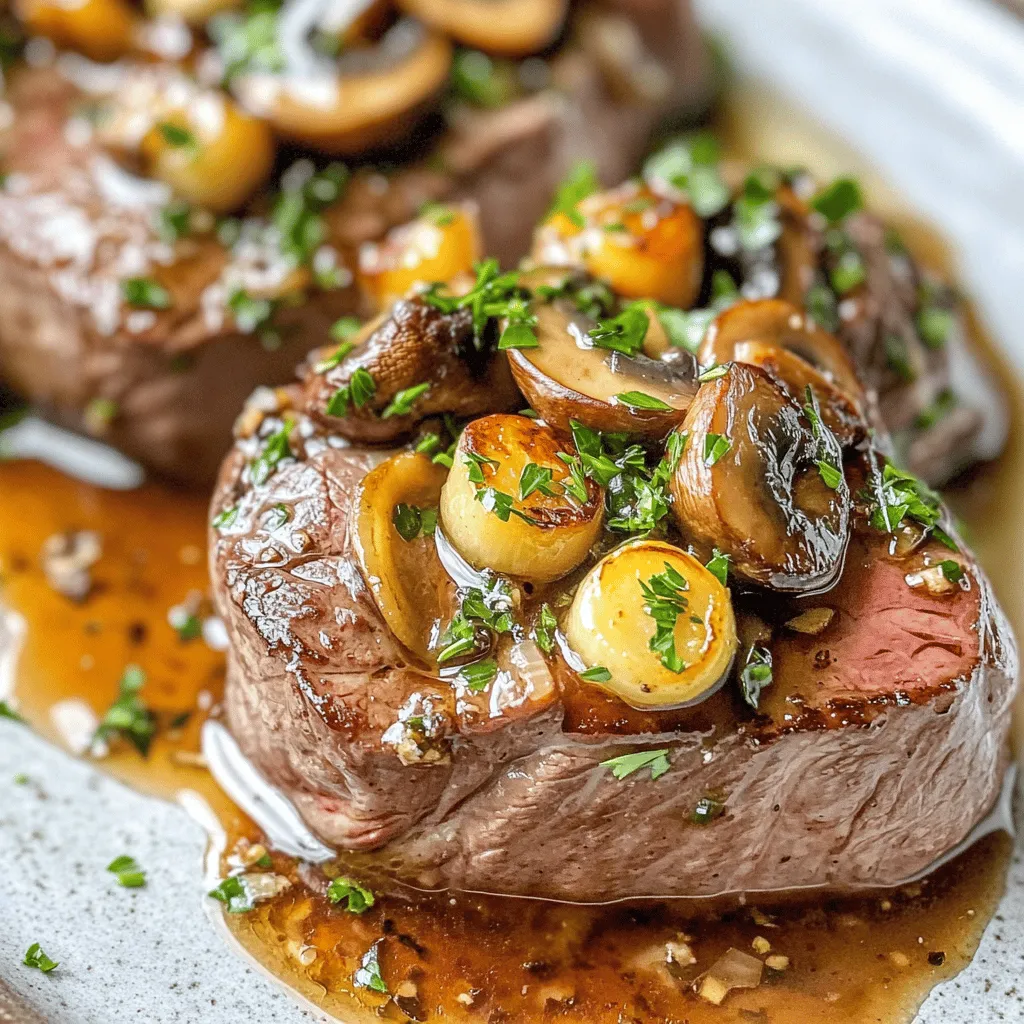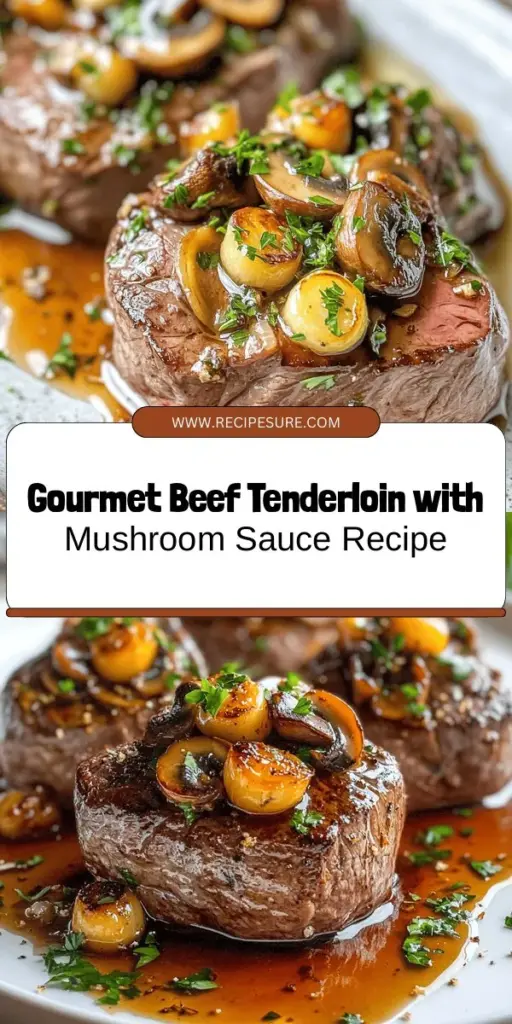Introduction
When it comes to culinary indulgence, few dishes can rival the sophistication and flavor of a savory beef tenderloin with rich mushroom sauce. This dish is the epitome of gourmet dining at home, perfectly suited for special occasions and intimate dinners alike. The allure of tender, succulent beef paired with a deeply flavorful, umami-packed mushroom sauce creates a dining experience that is both luxurious and comforting.
What sets this dish apart is not only its delectable taste but also its surprising simplicity. Despite its gourmet appearance, the recipe is accessible for home cooks, requiring just a few essential techniques to elevate the meal. With the right ingredients and a little bit of care, anyone can impress their guests or loved ones with this exquisite main course.
Let’s dive into the world of beef tenderloin, exploring its unique attributes and the essential ingredients that will ensure your dish is nothing short of spectacular.
The Allure of Beef Tenderloin
Beef tenderloin is a highly sought-after cut known for its exceptional tenderness and rich flavor. This premium cut comes from the loin of the cow, specifically the muscle that runs alongside the spine. Because this muscle does very little work, it results in a tender texture that melts in your mouth.
Characteristics of Beef Tenderloin Cuts
Beef tenderloin is typically sold as a whole piece or can be cut into individual steaks known as filet mignon. Each cut offers its own charm:
- Whole Tenderloin: Ideal for roasting or slicing into steaks, this cut can serve multiple guests and is perfect for a centerpiece dish.
- Filet Mignon: This is the most prized section of the tenderloin, known for its buttery texture. It is often considered the finest cut of beef and is perfect for those looking to treat themselves or others.
Tenderness and Flavor Profile
The tenderness of beef tenderloin is unmatched, making it a popular choice for fine dining. Its flavor is subtly rich, allowing it to pair beautifully with a variety of sauces and sides. The lack of excess fat means that while it is lean, it still retains a satisfying richness that can be enhanced with the right accompaniments.
Importance of Quality Beef
When preparing a dish centered around beef tenderloin, the quality of the meat is paramount. Look for grass-fed or organic options when possible, as these often have a more robust flavor and better texture. Quality beef not only elevates the taste of your dish but also contributes to a more enjoyable dining experience.
Choosing the Right Ingredients
The success of your savory beef tenderloin with rich mushroom sauce largely hinges on the quality and selection of ingredients. Each component plays a vital role in building depth of flavor and ensuring a memorable meal.
Beef Tenderloin Steaks
Choosing the right beef tenderloin is crucial. When selecting your steaks, consider the following tips:
- Look for Marbling: While tenderloin is lean, a little marbling (the white streaks of fat) can enhance flavor and juiciness.
- Color and Texture: Fresh beef should have a bright red color and a firm texture. Avoid any cuts that look dull or have excessive moisture.
Importance of Seasoning
The foundation of any great dish lies in its seasoning. For beef tenderloin, simple seasoning with salt and pepper allows the natural flavors of the meat to shine. Use coarse sea salt for a more pronounced flavor, and freshly cracked black pepper for an aromatic kick.
Olive Oil and Butter
These two ingredients form the base of your mushroom sauce. Olive oil adds a fruity depth, while butter introduces a rich creaminess that enhances the overall mouthfeel of the dish. Using a combination of both will create a balanced sauce that is both flavorful and luxurious.
Varieties of Mushrooms
Mushrooms are the stars of the sauce, and using a mix of varieties can elevate the dish significantly. Consider incorporating:
- Cremini: These mushrooms have a firm texture and a slightly stronger flavor than button mushrooms.
- Shiitake: Known for their rich, earthy flavor, shiitake mushrooms add depth to your sauce.
- Portobello: Their meaty texture makes them a great addition, adding to the umami profile of the sauce.
Role of Shallots and Garlic
Shallots and garlic are essential for building layers of flavor in your mushroom sauce. Shallots lend a mild sweetness, while garlic contributes a pungent, aromatic quality. Sautéing these aromatics before adding the mushrooms will create a fragrant base that enhances the overall taste.
Broth and Wine Choices
To deepen the flavor of your sauce, the choice of broth and wine is crucial. Opt for a rich beef broth to complement the meatiness of the tenderloin. When it comes to wine, a dry red wine like Cabernet Sauvignon or Merlot can add complexity and acidity, balancing the richness of the sauce.
Thyme and Dijon Mustard
Fresh thyme is a classic herb pairing for beef, lending an earthy note that complements the richness of the tenderloin. Additionally, a touch of Dijon mustard can introduce a subtle tang, enhancing the overall flavor profile of the sauce.
Optional Heavy Cream
While the sauce can be delicious without it, adding heavy cream towards the end of cooking creates a luxurious, velvety texture. This is particularly appealing if you prefer a creamier sauce, but it’s entirely optional based on personal preference.
Preparation Steps
Now that we’ve covered the ingredients, let’s look at the preparation process. Each step is critical in developing the flavors and textures that will make your savory beef tenderloin shine.
Preparing the Beef
Before you start cooking, it’s essential to properly prepare the beef. Begin by removing the tenderloin from the refrigerator about 30 minutes before cooking to allow it to come to room temperature. This step ensures even cooking throughout the steak.
Next, pat the beef dry with paper towels. Removing excess moisture is key to achieving a beautiful sear. After drying, generously season both sides of the tenderloin with salt and freshly cracked black pepper. This simple step will enhance the natural flavors of the beef.
Searing Technique
Searing the beef is where the magic happens. To achieve the perfect crust, heat a large skillet over medium-high heat and add a combination of olive oil and butter. The combination of these two fats allows you to reach higher temperatures while adding flavor.
Once the oil is shimmering, carefully place the seasoned beef tenderloin into the skillet. Avoid overcrowding the pan, as this can cause the beef to steam rather than sear. Cook for about 3-4 minutes on each side without moving the meat, allowing it to develop a deep, golden crust. For an even cook, you can also sear the edges of the tenderloin by holding it with tongs.
Creating the Mushroom Sauce
After the beef is perfectly seared, remove it from the skillet and let it rest on a cutting board. This resting period is crucial for allowing the juices to redistribute throughout the meat, ensuring every bite is flavorful and juicy.
In the same skillet, reduce the heat to medium and add more butter if necessary. Introduce finely chopped shallots and minced garlic to the pan, sautéing until fragrant and translucent. This step builds a flavorful foundation for your mushroom sauce.
Next, add a mix of your selected mushrooms to the skillet. Sauté the mushrooms until they release their moisture and become golden brown, which typically takes about 5-7 minutes. The mushrooms will absorb the flavorful remnants left from the beef, enhancing their taste.
Deglazing the Pan
To unlock the depth of flavor in your sauce, deglazing the pan is essential. Once the mushrooms are cooked, pour in a splash of red wine, scraping the bottom of the skillet with a wooden spoon to release any browned bits. This step not only adds complexity to the sauce but also infuses it with the rich flavors of the seared beef.
Allow the wine to reduce slightly before adding the beef broth, thyme, and Dijon mustard. Let the mixture simmer until it thickens to your desired consistency, which usually takes about 10 minutes. For a creamier sauce, stir in a splash of heavy cream at the end of cooking.
With these detailed preparation steps, you are well on your way to creating a stunning savory beef tenderloin with rich mushroom sauce that is sure to impress. Stay tuned for the next segment where we will dive into plating and serving suggestions, along with tips for the perfect dining experience.

Balancing Sauce Consistency: Tips for Achieving the Right Thickness
Achieving the perfect consistency for your mushroom sauce is essential for creating a delightful dish that clings beautifully to the beef tenderloin. Here are some tips to help you master this aspect of the recipe:
1. Start with a Roux: For a thicker sauce, consider starting with a roux—a mixture of equal parts flour and fat (like butter). Cook it until it’s light brown before adding your liquids. This will give your sauce a rich, velvety texture.
2. Simmer to Thicken: After adding your broth or wine to the sautéed mushrooms and aromatics, allow the mixture to simmer uncovered. This process evaporates excess liquid and concentrates the flavors, leading to a thicker sauce.
3. Use Cornstarch or Arrowroot: If you find your sauce too thin even after simmering, a slurry made from cornstarch or arrowroot can help. Combine one tablespoon of cornstarch with two tablespoons of cold water, then stir into the sauce. Continue cooking for a few minutes until the sauce thickens.
4. Finish with Cream: For a luxurious texture, consider adding a splash of heavy cream towards the end of cooking. It not only enriches the sauce but also helps in achieving that desired thickness.
Final Touches: Warming the Steaks in the Sauce for Maximum Flavor Integration
To truly elevate the flavors of your savory beef tenderloin, it’s beneficial to warm the steaks in the rich mushroom sauce just before serving. This technique ensures that the meat absorbs some of the sauce’s taste, enhancing the overall flavor profile of your dish.
1. Rest the Steak: After searing your beef tenderloin, allow it to rest for a few minutes. This step retains the juices within the meat and improves its texture.
2. Warm in Sauce: Slice the rested tenderloin into thick medallions and return it to the pan with the mushroom sauce over low heat. Let it warm for 2-3 minutes, spooning the sauce over the meat to ensure every bite is infused with flavor.
3. Serve Immediately: Once the steaks are warmed, plate them alongside the sauce. This not only enhances the taste but also creates an appealing visual presentation.
Cooking Techniques for Perfect Results
Understanding key cooking techniques will significantly improve your culinary skills and ensure the best results when preparing your savory beef tenderloin.
Searing vs. Other Cooking Methods: Benefits of High Heat
Searing is a fundamental technique in cooking beef tenderloin. By cooking the steak at high heat, you create a beautifully caramelized crust that enhances flavor and texture.
- Maillard Reaction: This chemical reaction occurs when proteins and sugars in the meat react under high heat, producing complex flavors and a rich brown color.
- Locking in Juices: Searing helps to lock in natural juices, leading to a more succulent steak.
The Science Behind Resting Meat: Enhancing Juiciness
Resting your steak after cooking is a crucial step that should not be overlooked.
- Juice Redistribution: When meat cooks, its juices are pushed towards the center. Allowing it to rest helps redistribute these juices throughout the steak, ensuring every bite is moist and flavorful.
- Optimal Resting Time: A good rule of thumb is to let your beef tenderloin rest for about 10 minutes before slicing.
Understanding Simmering: How It Affects Sauce Texture
Simmering is essential when developing your mushroom sauce.
- Flavor Concentration: Simmering allows flavors to meld and intensify, creating a more robust sauce.
- Texture Control: It helps reduce the sauce to the desired thickness without burning or overcooking the ingredients.
Adjusting Doneness: Tips for Cooking Steak to Preference
Cooking steak to the perfect doneness involves understanding your meat and using a reliable meat thermometer.
- Temperature Guidelines:
- Rare: 125°F (52°C)
- Medium-Rare: 135°F (57°C)
- Medium: 145°F (63°C)
- Medium-Well: 150°F (66°C)
- Well Done: 160°F (71°C) and above
- Use Instant-Read Thermometers: Insert the thermometer into the thickest part of the steak for an accurate reading.
Plating and Presentation
An appealing presentation can elevate your dish from delicious to extraordinary. Here’s how to plate your savory beef tenderloin for a stunning visual impact.
Importance of Garnishing with Fresh Parsley
A sprinkle of fresh parsley not only adds a pop of color but also a hint of freshness that balances the richness of the dish. Use flat-leaf parsley for its vibrant flavor and visually appealing texture.
Tips for Plating Techniques That Elevate the Dish
- Layering: Start with a base of the mushroom sauce, then place the sliced beef tenderloin on top. This technique creates height and dimension.
- Use a Ring Mold: For a restaurant-style presentation, consider using a ring mold to stack ingredients neatly.
- Drizzle Sauce: Use a spoon to drizzle additional mushroom sauce around the plate for an elegant touch.
Suggestions for Side Dishes That Complement the Beef Tenderloin
To create a well-rounded meal, consider serving your beef tenderloin with complementary side dishes:
- Garlic Mashed Potatoes: Their creaminess pairs beautifully with the savory sauce.
- Roasted Asparagus: The earthiness of asparagus enhances the dish while adding a healthy component.
- Creamed Spinach: This classic side dish provides a rich, velvety texture that pairs well with the beef.
Wine Pairing Suggestions
Choosing the right wine can enhance the flavors of your savory beef tenderloin and mushroom sauce. Here are some recommendations to elevate your dining experience.
Recommended Red Wines to Complement Beef Flavors
- Cabernet Sauvignon: Known for its robust structure and dark fruit notes, it pairs excellently with the richness of beef.
- Merlot: With its softer tannins and fruity flavors, Merlot provides a balanced pairing without overpowering the dish.
- Malbec: This wine’s bold flavor complements the deep umami notes of the mushroom sauce.
Suggestions for Wines That Balance the Richness of the Sauce
- Pinot Noir: Its acidity can cut through the creaminess of the sauce, providing a refreshing contrast.
- Zinfandel: With its jammy fruit flavors, it enhances the overall taste experience without overshadowing the beef.
Brief Overview of Food and Wine Pairing Principles
When pairing food with wine, consider these principles:
- Match Intensity: Pair lighter dishes with lighter wines and heavier dishes with fuller-bodied wines.
- Complement Flavors: Look for wines that echo the flavors in the food, such as earthy wines with mushroom dishes.
- Consider Acidity: Wines with higher acidity can brighten rich dishes, creating a balanced palate.
Nutritional Information
Understanding the nutritional benefits of your main ingredients can enhance your appreciation for this dish.
Breakdown of Protein Content in Beef Tenderloin
Beef tenderloin is an excellent source of high-quality protein, essential for muscle growth and repair. A 3-ounce serving provides approximately 22 grams of protein, making it a great choice for a hearty meal.
Nutritional Value of Mushrooms and Their Health Benefits
Mushrooms are not only flavorful but also packed with nutrients. They are low in calories and high in vitamins like B vitamins and minerals such as selenium. Additionally, they contain antioxidants that support immune function.
Discussion on Healthy Fats from Olive Oil and Butter
Using olive oil is a heart-healthy choice, rich in monounsaturated fats that can help lower bad cholesterol levels. While butter adds flavor, it should be used in moderation due to its saturated fat content. Together, they provide a balance of flavor and nutrition in your dish.
Conclusion
Preparing a savory beef tenderloin with rich mushroom sauce is not only a way to impress your guests but also a manageable culinary project for home cooks of all skill levels. By mastering key techniques like searing, resting meat, and balancing sauce consistency, you can create a dish that is both delicious and visually stunning.
With thoughtful plating, complementary side dishes, and the perfect wine pairing, your dining experience will be elevated to new heights. So gather your ingredients, follow the steps outlined in this recipe, and embark on a delightful culinary adventure that showcases the richness of flavors and the joy of cooking. Whether it’s a special occasion or a cozy dinner at home, this dish is sure to satisfy and impress, making it a memorable addition to your culinary repertoire.


